Page 166 of 566
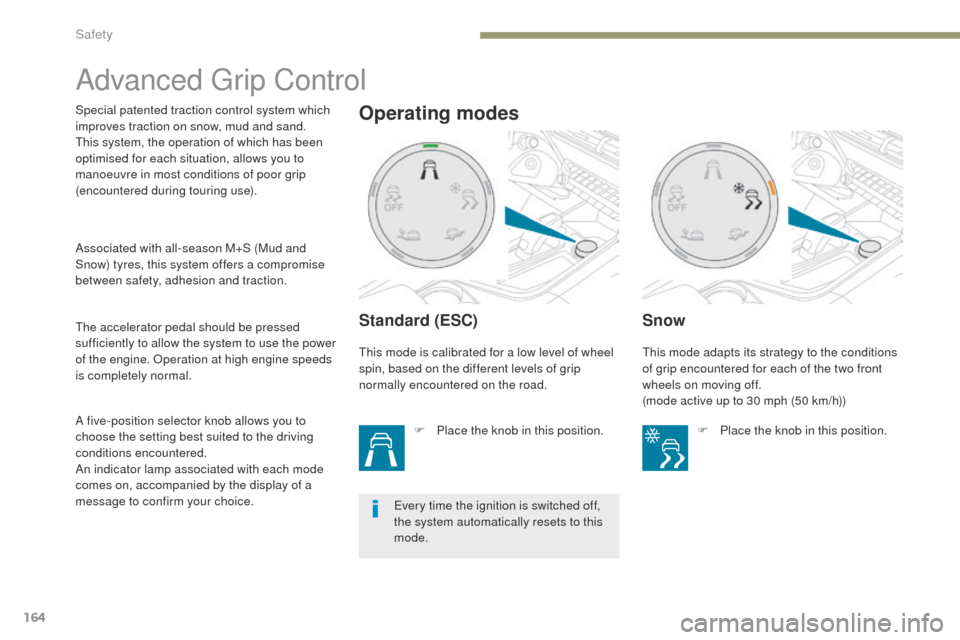
164
3008-2_en_Chap05_securite_ed01-2016
Advanced Grip Control
Standard (ESC)
F Place the knob in this position.
Snow
Special patented traction control system which
improves traction on snow, mud and sand.
This system, the operation of which has been
optimised for each situation, allows you to
manoeuvre in most conditions of poor grip
(encountered during touring use).This mode is calibrated for a low level of wheel
spin, based on the different levels of grip
normally encountered on the road.This mode adapts its strategy to the conditions
of grip encountered for each of the two front
wheels on moving off.
(mode active up to 30 mph (50 km/h))
F
P
lace the knob in this position.
The accelerator pedal should be pressed
sufficiently to allow the system to use the power
of the engine. Operation at high engine speeds
is completely normal.
Every time the ignition is switched off,
the system automatically resets to this
mode.
A five-position selector knob allows you to
choose the setting best suited to the driving
conditions encountered.
An indicator lamp associated with each mode
comes on, accompanied by the display of a
message to confirm your choice. Associated with all-season M+S (Mud and
Snow) tyres, this system offers a compromise
between safety, adhesion and traction.Operating modes
Safety
Page 167 of 566
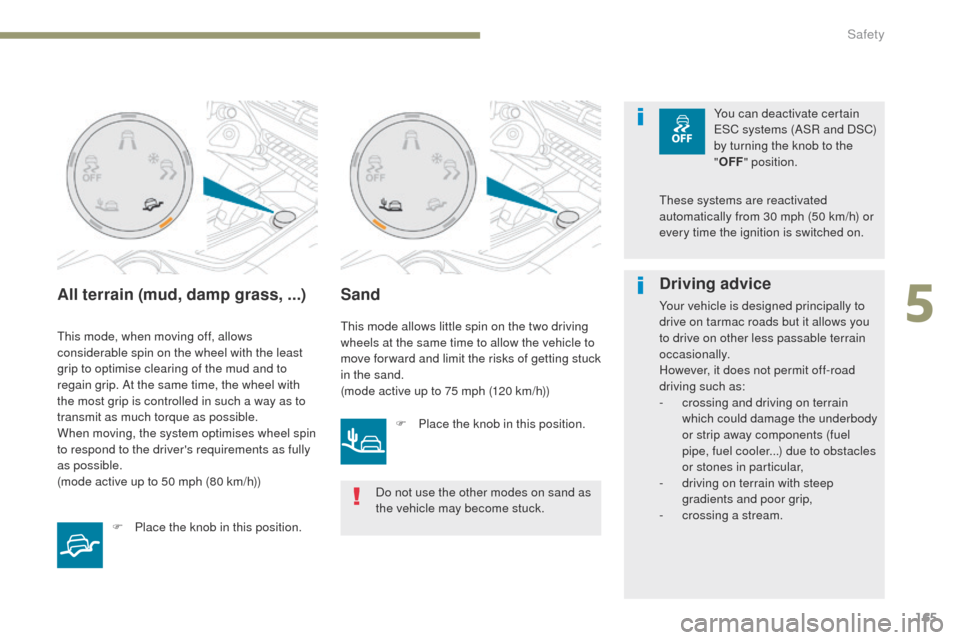
165
3008-2_en_Chap05_securite_ed01-2016
All terrain (mud, damp grass, ...)
This mode, when moving off, allows
considerable spin on the wheel with the least
grip to optimise clearing of the mud and to
regain grip. At the same time, the wheel with
the most grip is controlled in such a way as to
transmit as much torque as possible.
When moving, the system optimises wheel spin
to respond to the driver's requirements as fully
as possible.
(mode active up to 50 mph (80 km/h))F
P
lace the knob in this position.
Sand
This mode allows little spin on the two driving
wheels at the same time to allow the vehicle to
move for ward and limit the risks of getting stuck
in the sand.
(mode active up to 75 mph (120 km/h))F
P
lace the knob in this position. You can deactivate certain
ESC systems (ASR and DSC)
by turning the knob to the
"
OFF " position.
Driving advice
Your vehicle is designed principally to
drive on tarmac roads but it allows you
to drive on other less passable terrain
occasionally.
However, it does not permit off-road
driving such as:
-
c
rossing and driving on terrain
which could damage the underbody
or strip away components (fuel
pipe, fuel cooler...) due to obstacles
or stones in particular,
-
d
riving on terrain with steep
gradients and poor grip,
-
c
rossing a stream.
Do not use the other modes on sand as
the vehicle may become stuck. These systems are reactivated
automatically from 30 mph (50 km/h) or
every time the ignition is switched on.
5
Safety
Page 168 of 566
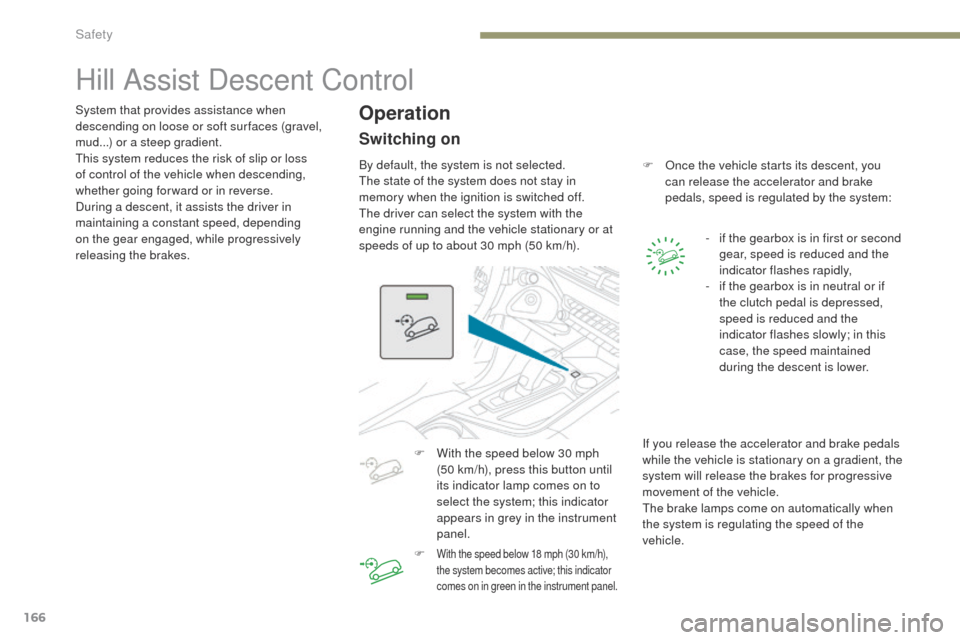
166
3008-2_en_Chap05_securite_ed01-2016
Hill Assist Descent Control
System that provides assistance when
descending on loose or soft sur faces (gravel,
mud...) or a steep gradient.
This system reduces the risk of slip or loss
of control of the vehicle when descending,
whether going forward or in reverse.
During a descent, it assists the driver in
maintaining a constant speed, depending
on the gear engaged, while progressively
releasing the brakes.Operation
By default, the system is not selected.
The state of the system does not stay in
memory when the ignition is switched off.
The driver can select the system with the
engine running and the vehicle stationary or at
speeds of up to about 30 mph (50 km/h).F
O nce the vehicle starts its descent, you
can release the accelerator and brake
pedals, speed is regulated by the system:
-
i
f the gearbox is in first or second
gear, speed is reduced and the
indicator flashes rapidly,
-
i
f the gearbox is in neutral or if
the clutch pedal is depressed,
speed is reduced and the
indicator flashes slowly; in this
case, the speed maintained
during the descent is lower.
Switching on
F With the speed below 30 mph (50 km/h), press this button until
its indicator lamp comes on to
select the system; this indicator
appears in grey in the instrument
panel.
F
With the speed below 18 mph (30 km/h),
the system becomes active; this indicator
comes on in green in the instrument panel.
If you release the accelerator and brake pedals
while the vehicle is stationary on a gradient, the
system will release the brakes for progressive
movement of the vehicle.
The brake lamps come on automatically when
the system is regulating the speed of the
vehicle.
Safety
Page 170 of 566
168
3008-2_en_Chap05_securite_ed01-2016
F To adjust the anchorage point, squeeze the control A and slide it to one of the notches.
Height adjustment
Seat belts
Front seat belts
The front seat belts are fitted with a
pretensioning and force limiting system.
This system improves safety in the front
seats in the event of a front or side impact.
Depending on the severity of the impact, the
pretensioning system instantly tightens the seat
belts against the body of the occupants.
The pretensioning seat belts are active when
the ignition is on.
The force limiter reduces the pressure of the
seat belt on the chest of the occupant, so
improving their protection.Fastening
Unfastening
F Press the red button on the buckle.
F G uide the seat belt as it reels in.
F
P
ull the strap, then insert the tongue in the
buckle.
F
C
heck that the seat belt is fastened
correctly by pulling the strap.
Safety
Page 171 of 566
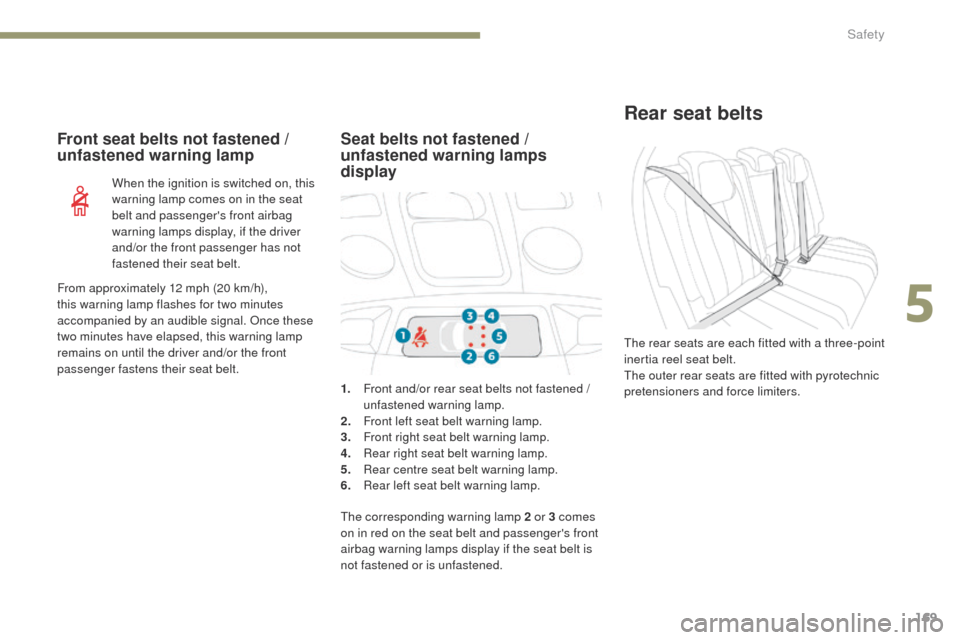
169
3008-2_en_Chap05_securite_ed01-2016
Rear seat belts
The rear seats are each fitted with a three-point
inertia reel seat belt.
The outer rear seats are fitted with pyrotechnic
pretensioners and force limiters.
Front seat belts not fastened /
unfastened warning lamp
When the ignition is switched on, this
warning lamp comes on in the seat
belt and passenger's front airbag
warning lamps display, if the driver
and/or the front passenger has not
fastened their seat belt.1.
F
ront and/or rear seat belts not fastened /
unfastened warning lamp.
2.
F
ront left seat belt warning lamp.
3.
F
ront right seat belt warning lamp.
4.
R
ear right seat belt warning lamp.
5.
R
ear centre seat belt warning lamp.
6.
R
ear left seat belt warning lamp.
Seat belts not fastened /
unfastened warning lamps
display
The corresponding warning lamp 2 or 3 comes
on in red on the seat belt and passenger's front
airbag warning lamps display if the seat belt is
not fastened or is unfastened.
From approximately 12 mph (20 km/h),
this warning lamp flashes for two minutes
accompanied by an audible signal. Once these
two minutes have elapsed, this warning lamp
remains on until the driver and/or the front
passenger fastens their seat belt.
5
Safety
Page 172 of 566

170
3008-2_en_Chap05_securite_ed01-2016
Fastening
F Pull the strap, then insert the tongue in the buckle.
F
C
heck that the seat belt is fastened
correctly by pulling the strap.
Unfastening
F Press the red button on the buckle.
F G uide the seat belt as it reels in. This warning lamp comes on in
the seat belt and passenger's front
airbag warning lamps display,
when one or more rear passengers
unfasten their seat belt.
Seat belt unfastened warning
lamp
Seat belt unfastened warning
lamps display
When the ignition is switched on, with the
engine running or when the vehicle is moving at
less than 12 mph (20 km/h), the corresponding
warning lamps 4
, 5 and 6 come on in red for
approximately 30 seconds, if the seat belt is not
fastened.
When the vehicle is moving at more than
12
mph (20 km/h), the corresponding warning
lamp 4 , 5 or 6 comes on in red, accompanied
by an audible signal and the display of a
message, if a rear passenger has unfastened
their seat belt.
From approximately 12 mph (20 km/h),
this warning lamp flashes for two minutes
accompanied by an audible signal. Once the
two minutes have elapsed, this warning lamp
remains on until one or more rear passengers
fasten their seat belt.
Safety
Page 174 of 566
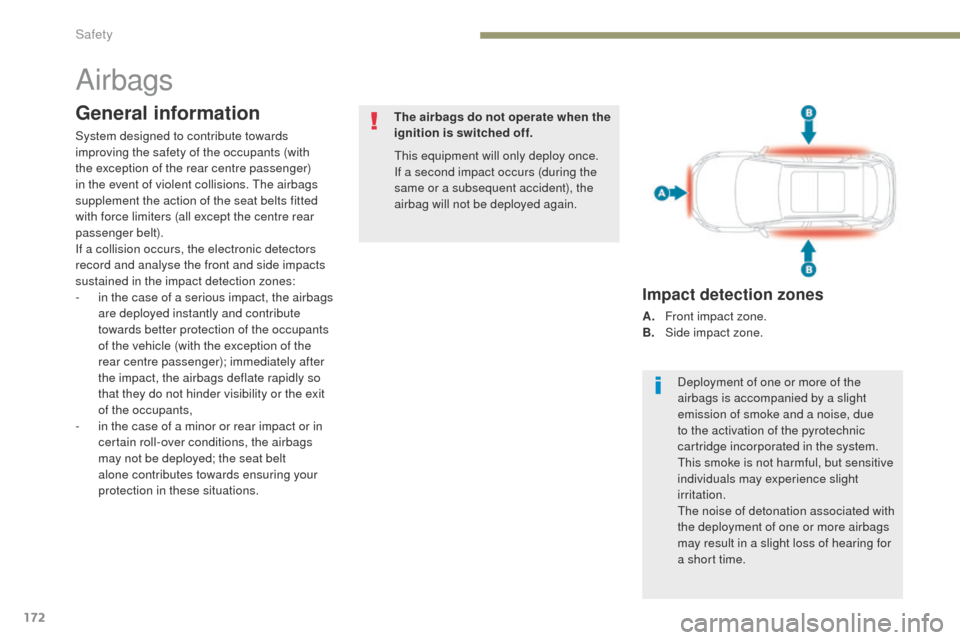
172
3008-2_en_Chap05_securite_ed01-2016
Airbags
General information
System designed to contribute towards
improving the safety of the occupants (with
the exception of the rear centre passenger)
in the event of violent collisions. The airbags
supplement the action of the seat belts fitted
with force limiters (all except the centre rear
passenger belt).
If a collision occurs, the electronic detectors
record and analyse the front and side impacts
sustained in the impact detection zones:
-
i
n the case of a serious impact, the airbags
are deployed instantly and contribute
towards better protection of the occupants
of the vehicle (with the exception of the
rear centre passenger); immediately after
the impact, the airbags deflate rapidly so
that they do not hinder visibility or the exit
of the occupants,
-
i
n the case of a minor or rear impact or in
certain roll-over conditions, the airbags
may not be deployed; the seat belt
alone contributes towards ensuring your
protection in these situations.
Impact detection zones
A. Front impact zone.
B. S ide impact zone.
The airbags do not operate when the
ignition is switched off.
This equipment will only deploy once.
If a second impact occurs (during the
same or a subsequent accident), the
airbag will not be deployed again.
Deployment of one or more of the
airbags is accompanied by a slight
emission of smoke and a noise, due
to the activation of the pyrotechnic
cartridge incorporated in the system.
This smoke is not harmful, but sensitive
individuals may experience slight
irritation.
The noise of detonation associated with
the deployment of one or more airbags
may result in a slight loss of hearing for
a short time.
Safety
Page 176 of 566
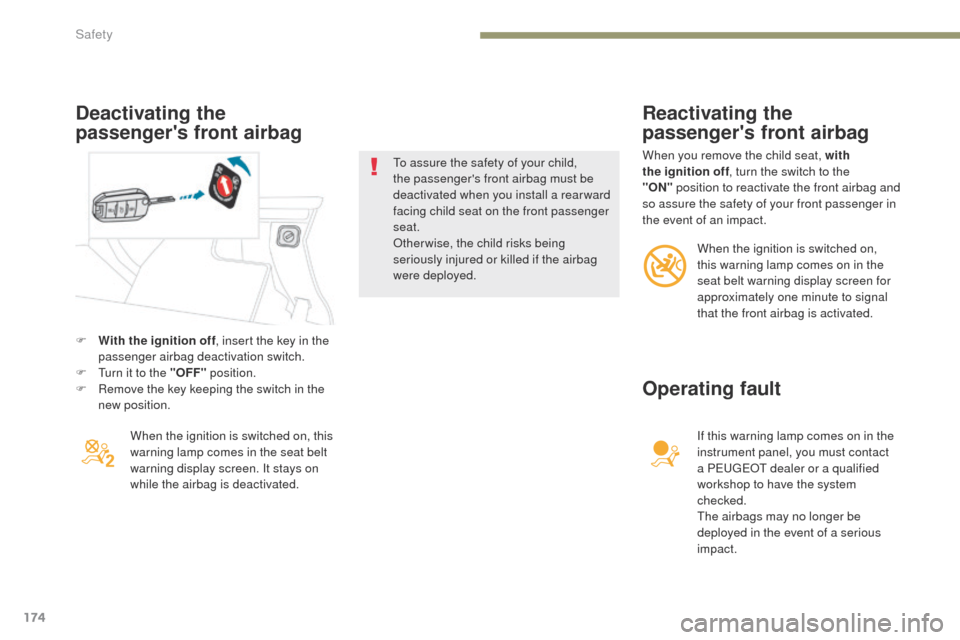
174
3008-2_en_Chap05_securite_ed01-2016
F With the ignition off, insert the key in the
passenger airbag deactivation switch.
F
T
urn it to the "OFF" position.
F
R
emove the key keeping the switch in the
new position.
Reactivating the
passenger's front airbag
When you remove the child seat, with
the ignition off , turn the switch to the
"ON"
position to reactivate the front airbag and
so assure the safety of your front passenger in
the event of an impact.
When the ignition is switched on, this
warning lamp comes in the seat belt
warning display screen. It stays on
while the airbag is deactivated. To assure the safety of your child,
the passenger's front airbag must be
deactivated when you install a rear ward
facing child seat on the front passenger
seat.
Otherwise, the child risks being
seriously injured or killed if the airbag
were deployed.
When the ignition is switched on,
this warning lamp comes on in the
seat belt warning display screen for
approximately one minute to signal
that the front airbag is activated.
If this warning lamp comes on in the
instrument panel, you must contact
a PEUGEOT dealer or a qualified
workshop to have the system
checked.
The airbags may no longer be
deployed in the event of a serious
impact.
Operating fault
Deactivating the
passenger's front airbag
Safety